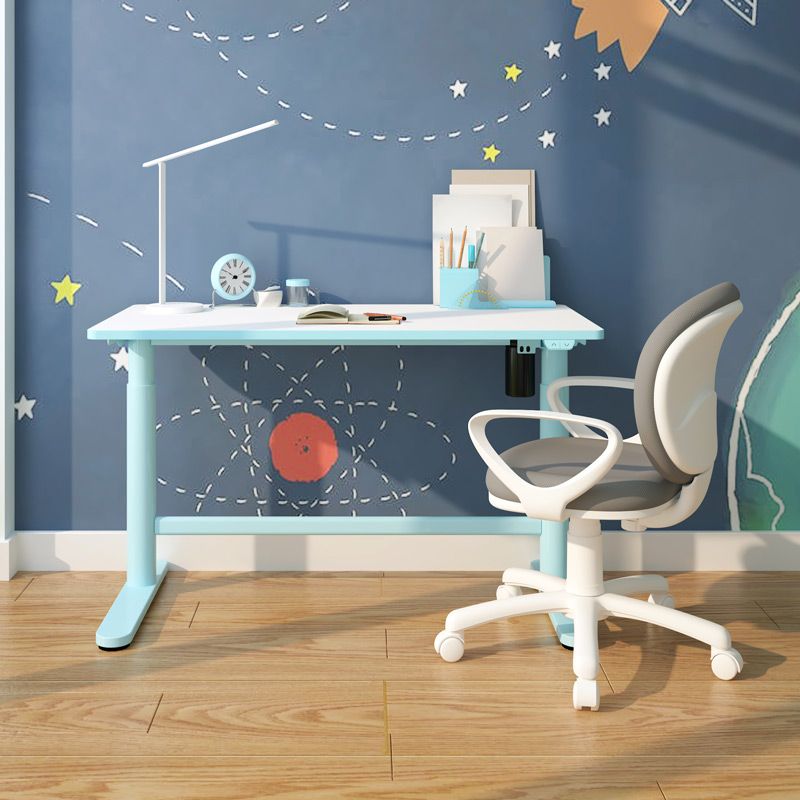Below are several useful tips for transforming (or creating from scratch) a productive, comfortable and happy workspace for your child:
#1 Location Location Location
All children require slightly different things to feel comfortable and be productive. Carefully consider what kind of space would best suit your child.
Does your child like to work on their homework with a parent or sibling? In this case, larger spaces like the kitchen, family room or home office would allow for communal homework-ing and provide a light buzz as background noise.
Or does your child prefer to work alone and in the quiet? Somewhere tucked away from the bustle of the home best suits independent workers, for example in their bedroom, a spare bedroom or a tucked-away nook.
Either way, avoid family thoroughfares to minimise distractions.
#2 Set Up
While it might be tempting to let your child go wild in a furniture store and pick out the glitziest desk and chair set imaginable, there are important considerations to keep in mind when selecting desks for children.
As your child’s body is still developing, the comfort and ergonomic support offered by your child’s desk and chair is vital.
Desks should be around waist-height. The desk chair should be low enough so that your child’s feet touch the floor. Your child’s elbows should also rest nicely on the desk without their shoulders bunching up.
Height-adjustable desks and chairs are a spend-conscious parent’s best friend here, as they will grow as your child grows, like this example below by FlexiSpot.

FlexiSpot’s Kids Desk for Home-Schooling and Chair Set (available in different colours)
Key features to look for when searching for a child’s desk:
- Waterproof and hygienic desktop which is easy to clean
- Rounded edges to avoid bumps and bruises
- Furniture which promotes good posture (i.e. a desk which is the correct height for your child)
- Furniture which will continue to work for your child as they grow, like a height-adjustable desk
- A chair with effective back support
- Organisational and storage features or add-ons
#3 Lighting
Effective lighting is very important for study spaces as dim lighting can strain the eyes and will decrease your child’s motivation.
Ensure that desktop lighting is bright - use a combination of overhead lighting and a desk lamp which can be pointed directly at their homework. Try an anti-glare screen protector if your child spends a long time on the computer.
Equally, lighting can be used to make a space feel homely (and therefore familiar and reassuring). To add a sense of warmth and comfort, try adding a string of decorative lights above the desk, or a lamp which offers a warm glow for reading.
#4 Organisation and Supplies
Teach your child some key organisational skills to help them stay on top of their homework and develop positive habits for later life.
Encourage them to keep track of their homework by installing a bulletin board or whiteboard above their desk. Or encourage them to use Post-It notes or a calendar to keep on top of everything.
Keep their desk well-stocked with the stationery items which your child regularly uses. A trip to your local stationery supplier could be posed as a reward for their hard work, from which they can stock up on exciting items like glitter and stickers, as well as the essentials.
Encourage your child to keep their desk tidy and to tuck everything away at the end of their study time. Use small boxes or drawers to keep the desk decluttered and organised. A backpack hook next to their desk is a great way to keep your child’s work in one easy-to-access place.
#5 Space for Creativity and Fun
Encourage your child to view their study space as a place where creativity and fun can happen. Avoid negative connotations about their desk forming in your child’s mind by using the space for activities which they enjoy too. Keep the necessary supplies for these activities by the desk, perhaps in under-desk-storage or in a special creativity box.
Some examples of creative and fun activities which your child might enjoy at their desk include:
- Painting and art
- Writing letters and postcards to friends and family
- Reading
- Building with building blocks or other materials
- Puzzles
- Writing in a diary
- Designing
- Playing computer games (though not during study time!)
#6 Personalisation
Encourage your child to personalise their space. This will create a sense of ownership and responsibility, as well as being a mood-booster!
Posters, pictures and plants can make a space feel more personalised and comfortable, and can even provide inspiration.
Pinning up certificates and past artwork around their study space will also give your child confidence and motivation.
#7 Distraction-Free
Remove any unnecessary devices from your child’s study space and ensure noises from devices in other rooms, like the TV, cannot be heard while your child studies.
Use background music or soundscapes to cover up unavoidable external noises.
Ration device time. Use internet controls to block access to non-educational websites during homework time.